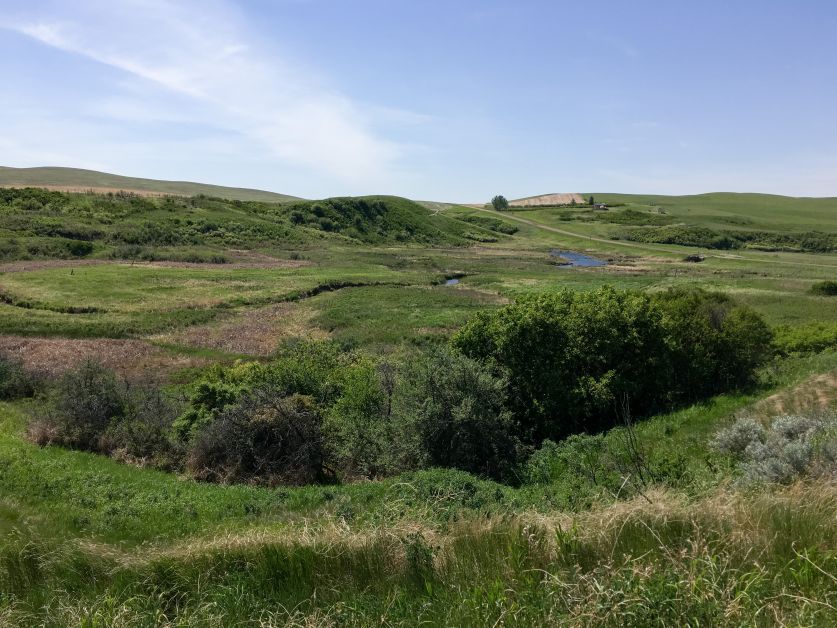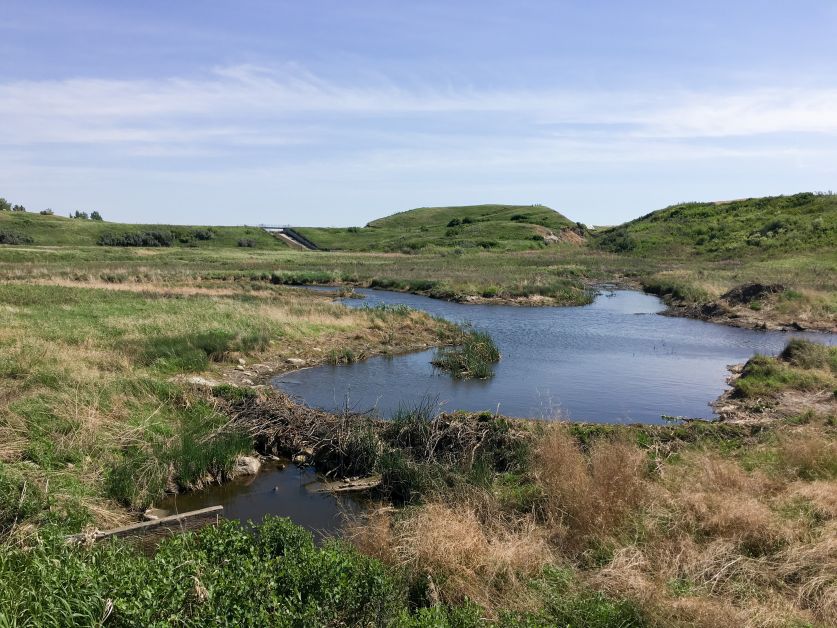Some days are just huge demonstrations of that fact that beaver knowledge isn’t evenly distributed.Take today for instance where there is a wonderful article about doing a beaver installation in Alberta, juxtaposed with an stunningly ignorant article about beavers chasing fleeing motorcycle-riding trappers by leaping on their pogo-stick tail.
No. I’m serious.
Keep in mind that it’s summer and beaver parents are protecting their new kits by getting rid of anyone that doesn’t belong there. Meanwhile, dog walkers let their hot pooches take a swim, (and to be perfectly honest yearlings are probably in a fowl mood anyway because they are just realizing they aren’t the baby anymore). July and June are the time of year we read frantic articles about beavers attacking dogs. And no one seems to get that the assault pattern is seasonal.
Canada’s beaver problem
Not expecting to get chased by a beaver that he claims had aerial capabilities, Donnie Springer once set out to hunt a moose. He drove a three-wheel dirt bike in front of his father-in-law, around Devil’s Lake, Man., but soon realized his father-in-law was missing. Springer turned back, and found the man speeding away from a bucktooth terror. The beaver then turned on Springer.
The beaver first chased him using its typical method of running on its legs. However, Springer was riding at about 25km/hr, he recalls of an incident around the year 2000. For the beaver to catch up, Springer claims it deployed its tail as a spring. “It would sit on its tail, and it would go shooting itself about 10 feet in the air,” he says. “It would use its tail to propel itself … he was just a givin’ ‘er”
There is a perception in several parts of Canada that beavers are invading. In June, CTV reported that the city of Edmonton put up signs warning dog owners about dangerous beavers after several beaver attacks on pets, and the Winnipeg Free Press reported recently beavers “wreaking havoc in parts of Manitoba on a scale not seen in a lifetime.” Saskatchewan inaugurated a controversial beaver-hunting derby last spring, which reaped 589 kills, and some municipalities have introduced bounties. Farmers continue to bereave the flooding of fields; drivers, of roads, and cottagers, the loss of their favourite trees. The population is in fact surging, and the species even became a recent fascination of genome researchers.
What to say when an article uses the ‘springing beaver’ accusation as a story’s lead? The mind reals, the jaw drops. It’s not the first time I’ve read these allegations from a Canadian trapper either. Do you think they watched too many ‘Tigger’ cartoons as youngsters? There was a story about Yellow Knife that had a trapper accusing them of lunging forth by bouncing on their tails. Maybe it’s a collective hallucination?
What I will say is that Moses did tell me one night while filming he saw what looked like a beaver fight, and see what appeared to be a beaver lunge on it’s tail. He was so surprised he didn’t get footage, so he has no proof and isn’t always the most reliable reporter so who knows? When I was 11 I was certain if you said ‘bloody mary’ over and over at a pajama party she would appear in the bathroom mirror. And I saw it twice!
There are strange things done in the midnight sun
By the men who moil for gold;
The Arctic trails have their secret tales
That would make your blood run cold;
The Northern Lights have seen queer sights,
But the queerest they ever did see
Was that beaver male leap on his tail
And bounce after Sam McGee
Ahh, my apologies to Robert, but you knew it had to be done. Now that it’s on your mind, go read that poem again, it’s such a fun tale, er tail!
Thank goodness for this other story in the morning, which is every bit as wise as the former was stupid, proving that the entire country has not all lost it’s collective minds.
Michichi boardwalk project approved
 As a new way to engage people into real-time educational experiences, the Michichi boardwalk has now been approved. The three-phase project is set to begin in late fall with construction of the boardwalk to be closely monitored as not to disrupt too much of the surrounding environment.
As a new way to engage people into real-time educational experiences, the Michichi boardwalk has now been approved. The three-phase project is set to begin in late fall with construction of the boardwalk to be closely monitored as not to disrupt too much of the surrounding environment.
“We’re going to have a bit of frost in the ground and that’s going to help a lot with the equipment going in and making ruts and stuff like that,” said Starland County Agricultural Fieldman Dara Kudras.
“There will be some damage but that is the price we have to pay to get this boardwalk in there.”
They have hired a company that has smaller equipment to cause a tinier carbon footprint.
“What we are aiming for is minimal disturbance just because it is a sensitive area,” said Kudras.
The project has three phases to smoothly add the boardwalk into the region as well as create a healthy riparian monitoring program and pond leveller.
The beaver dam which is built every year, is located where the spillway is. By springtime, the water level becomes too high causing the dam to break and the water to drain.
“If the beavers weren’t there building that dam, then all the water goes out and there is no habitat area,” said Kudras. A pond leveLler is a large plastic tube that is put through the middle of the dam where a cage is placed on one end of the tube.
“It’s so the water can go through and the dam won’t blow out and the beavers won’t have to build so high either,” said Kudras. “It will allow water to go through without wrecking the dam.”
Instinctively, if the dam does happen to break, beavers will find trees to repair and rebuild. Instead of allowing them to take out new trees in the area, Kudras and her team have been gathering other already fallen branches or vegetation for the beavers to use.
“That’s part of the coexistence part of it that we want to be able to grow trees there and keep beavers happy at the same time,” said Kudras.
 $12,000 of the grant is going towards signage along the boardwalk to help explain the usage of the pond leveller and other interesting facts about the riparian area and what it has to offer. Different types of birds and other animals will be on the signs as well. Of the total budget, the largest cost of $80,000 will be going towards the actual construction of the boardwalk.
$12,000 of the grant is going towards signage along the boardwalk to help explain the usage of the pond leveller and other interesting facts about the riparian area and what it has to offer. Different types of birds and other animals will be on the signs as well. Of the total budget, the largest cost of $80,000 will be going towards the actual construction of the boardwalk.
A 20-foot by 16-foot viewing deck area with seating and a gazebo close to the dam will be a special addition to the boardwalk with the possibility of up to two bridges depending on the budget.
“If local craftsman or local schools want to come and a have like a wetland field day and learn about the ecosystem in the area and stuff like that, then they can come out and use that,” said Kudras. “We’re just trying to make it really accessible for everybody.”
Starland County is putting $32,000 forward as the lead administrator and will be partnering up with the current landowner of the area as well as Cows & Fish and the Red Deer River Watershed Alliance.
After the project is finished, an established riparian monitoring program will be put in place, a pond leveller will be constructed and implemented, and the half kilometer long boardwalk will be complete.
A grand opening is expected to happen shortly after everything is in place. Kudras plans to increase awareness and get help from local farmers to build up drought and flood resilience.
“This project is a cornerstone going into the future with the rest of the watershed resilience restoration program,” said Kurdas.
Have you hugged Cows and Fish this morning? I think I might name my firstborn after Mr. Kurdras. This is just such a smartly designed and coordinated project. I can’t think of anywhere better to spend an early morning than on their finished boardwalk watching beavers that have had trees planted for them to do their work. And a trail with interpretive signs explaining what everyone is seeing. This is fantastic! Maybe you want to use this?
 A final note comes from Napa where Rusty says that he met up with Brock, Kate and Ben on a field trip to visit some urban beavers. Rusty invited county supervisor Brad Wagenecht to join them and they all hung out for a bit with our Napatopia beavers. Maybe the wine country beavers will even make it into the book?
A final note comes from Napa where Rusty says that he met up with Brock, Kate and Ben on a field trip to visit some urban beavers. Rusty invited county supervisor Brad Wagenecht to join them and they all hung out for a bit with our Napatopia beavers. Maybe the wine country beavers will even make it into the book?




 This important and accessible book surveys the history and present condition of river systems across the United States, showing how human activities have impoverished our rivers and impaired the connections between river worlds and other ecosystems. Ellen Wohl begins by introducing the basic physical, chemical, and biological processes operating in rivers. She then addresses changes in rivers resulting from settlement and expansion, describes the growth of federal involvement in managing rivers, and examines the recent efforts to rehabilitate and conserve river ecosystems. In each chapter she focuses on a specific regional case study and describes what happens to a particular river organism—a bird, North America’s largest salamander, the paddlefish, and the American alligator—when people interfere with natural processes.
This important and accessible book surveys the history and present condition of river systems across the United States, showing how human activities have impoverished our rivers and impaired the connections between river worlds and other ecosystems. Ellen Wohl begins by introducing the basic physical, chemical, and biological processes operating in rivers. She then addresses changes in rivers resulting from settlement and expansion, describes the growth of federal involvement in managing rivers, and examines the recent efforts to rehabilitate and conserve river ecosystems. In each chapter she focuses on a specific regional case study and describes what happens to a particular river organism—a bird, North America’s largest salamander, the paddlefish, and the American alligator—when people interfere with natural processes. tationed where they primarily reside.
tationed where they primarily reside.









































